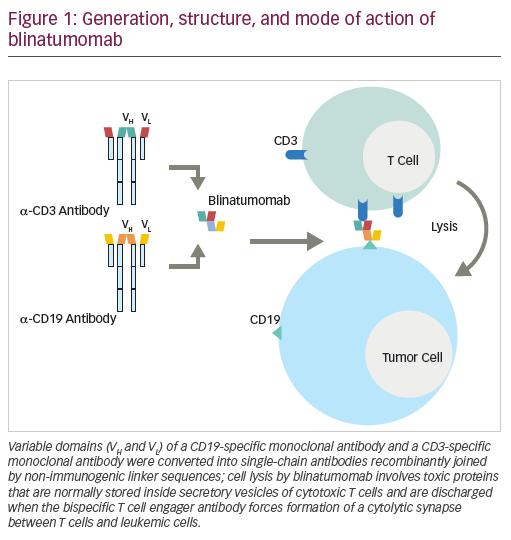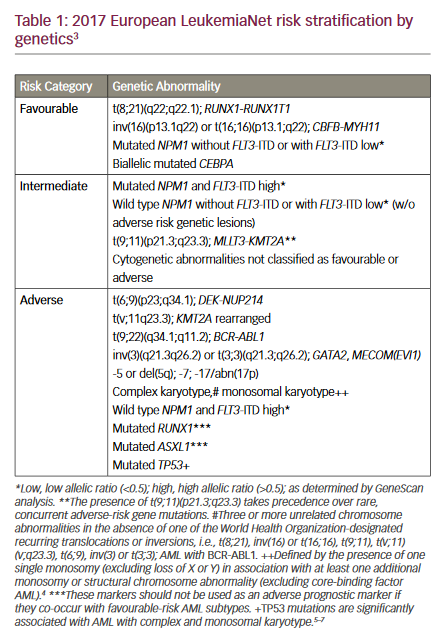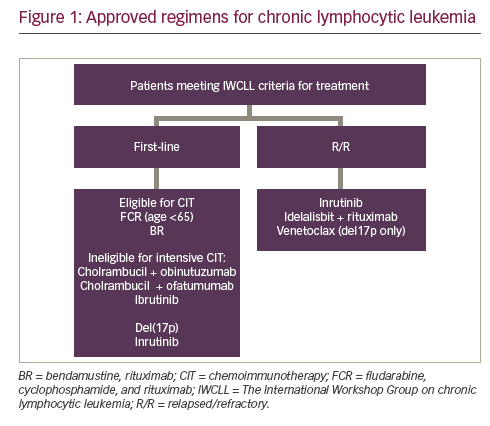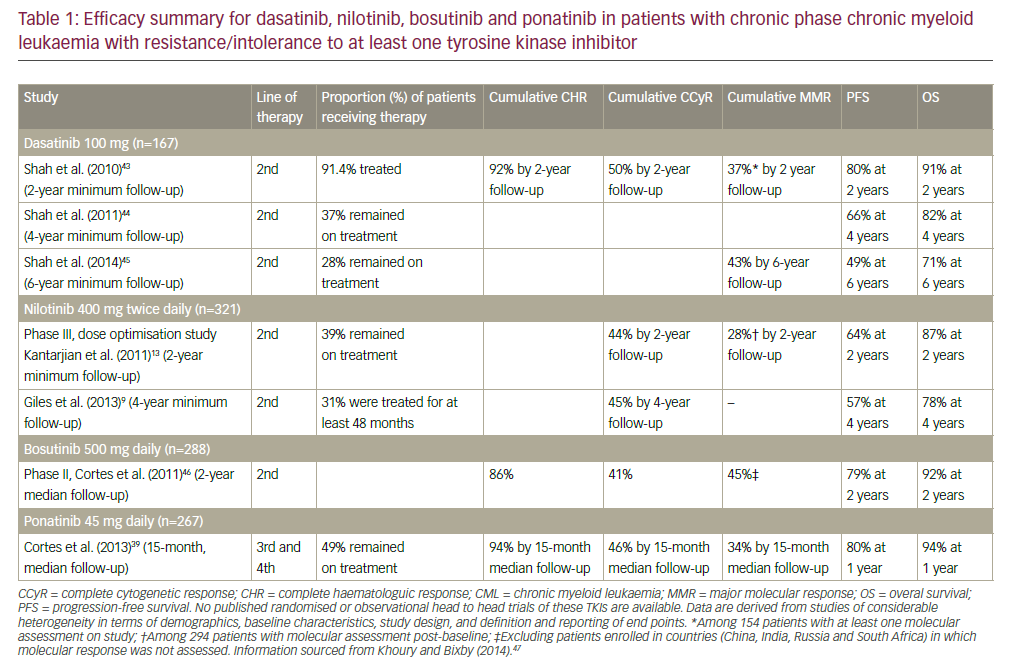Acute myeloid leukaemia (AML) is a genetically heterogeneous group of leukaemias that result from clonal transformation of haematopoietic precursors through the acquisition of chromosomal rearrangements and multiple gene mutations. In the absence of treatment, AML progresses rapidly, resulting in bone marrow failure, anaemia, fatal infection, bleeding and organ infiltration. The incidence of AML increases with age, with 70 years the median age at diagnosis.1 In Europe, the incidence of AML in adults is 5–8 cases/100,000/year, while the mortality rate is 4–6 cases/100,000/year.2 Treatment of AML consists of two phases: induction therapy, which aims to produce complete remission (CR), and post-remission (consolidation) therapy, which aims to prolong the CR. For the past 30 years, the standard induction therapy for AML has consisted of cytarabine in conjunction with an anthracycline, such as daunorubicin or idarubicin.1 In general, following induction therapy, the CR rate is 50–75 % in adult patients.1,3,4 The major determinants of prognosis for patients with AML are age, cytogenetics and FLT3/NPM1 gene mutation profile.5 After CR, however, the majority of patients relapse, giving rise to a more resistant leukaemia.6 The prognosis for relapsed or refractory AML patients is poor and there is no standard treatment.7 For patients who achieve CR, AML may be curable by stem cell transplantation. The introduction of new drugs and therapeutic regimens that have been shown to achieve CR in a greater number of patients could potentially result in more transplants being performed, and consequently increased cure rates in relapsed or refractory AML patients. New therapies for the treatment of relapsed/refractory AML represent an unmet clinical need. This article will discuss the use of elacytarabine, a promising new agent in the treatment of relapsed/refractory AML.
Current Treatment Options for Refractory/Relapsed Acute Myeloid Leukaemia
At the current time, there is no treatment specifically approved for relapsed/refractory AML. Cytarabine (1-ß-D-arabinofuranosylcytosine, ara-C) given at intermediate (1 g/m2) and high (2–3 g/m2) doses is the mainstay of second-line treatment for relapsed AML.5 Common salvage regimens are cytarabine for six days (2–3 g/m2 every 12 hours) or a combination of cytarabine (3 g/m2 every 12 hours on days 1, 3, 5 and 7) with either daunorubicin (50 mg/m2) or idarubicin (10 mg/m2) on days 2, 4 and 6.5
Cytarabine is a deoxynucleoside analogue which, following intracellular conversion to the active triphosphate metabolite of cytarabine (ara-CTP) causes irreversible inhibition of DNA synthesis by becoming permanently bound into elongating DNA strands.8,9 This in turn leads to chain termination, inhibition of further DNA synthesis, DNA fragmentation and induction of apoptosis.10
Monophosphorylation of cytarabine by deoxycytidine kinase (dCK) is the rate-limiting step in intracellular conversion to ara-CTP.11 The efficacy of cytarabine is heavily dependent on dose and schedule because of its short biological half-life. This is due to a rapid deamination into uracil arabinoside (ara-U) by the enzyme cytidine deaminase in the blood, liver, kidneys and intestine.12 The chemotherapeutic efficacy of cytarabine varies dramatically between individuals,13 with relapsed leukaemia representing a considerable therapeutic challenge. At least two distinct mechanisms of cytarabine resistance have been identified in leukaemic cells.14 Resistance can be due to altered nucleoside transport (leading to a reduction in intracellular concentrations of the drug).15,16 Resistance can also result from reduced intracellular activation due to high deaminase activity (which inactivates cytarabine), low dCK activity (which decreases the production of active metabolites)17 or high cytosolic 5’-nucleotidase II (which dephosphorylates cytarabine monophosphate to cytarabine).18
Role of Nucleoside Transporters in Resistance to Cytarabine
Cytarabine is a hydrophilic molecule, and therefore its entry into tumour cells requires the expression of nucleoside-specific membrane transport carriers. The human equilibrative nucleoside transporter-1 (hENT1) is responsible for 80–90% of the total transmembrane transport of pyrimidine nucleosides19 and 80 % of cytarabine influx into human leukaemic blast cells.20 Transport of cytarabine into the cancer cell is important, as intracellular concentrations of ara-CTP correlate with clinical outcomes.21 Further supporting this, it has been noted that some cancers have low levels of hENT1 and respond poorly to nucleoside analogues.16
Several studies have further highlighted the association between hENT1, intracellular transport and cytarabine resistance.22–24 It has been demonstrated in vitro that hENT1-deficient cells are highly resistant to cytarabine, while transfection with the hENT1 gene sensitised the cells to the drug.24 Hubeek et al. found a significant correlation between hENT1 messenger RNA (mRNA) expression and in vitro response to cytarabine in 50 samples from paediatric AML patients (product–moment correlation [rp] -0.46, p=0.001), with threefold lower hENT1 mRNA levels found in resistant patients (p=0.003).23 Additionally, in a study of 77 AML patients, deficient expression of hENT1 mRNA was associated with an increased risk of relapse and a significant reduction in long-term survival.22 The importance of hENT1 was further illustrated in a study of 123 cytarabine-treated patients, where patient hENT1 deficiency was related to shorter disease-free survival.25
The abundance of hENT1 is variable in AML patients; however, the number of nucleoside transport sites (NTSs) on blast cells has been noted to closely correlate with intracellular accumulation of ara-CTP26 and sensitivity to cytarabine.27 Gati et al. observed that within leukaemic myeloblasts from nine patients there was a sixfold variation in the number of hENT1 sites (as determined by flow cytometry and the use of a fluorescent hENT1-binding molecule).27 In their study, sensitivity of leukaemic myeloblasts to cytarabine was shown to correlate with the abundance of functional nucleoside transporters. Wiley et al. also noted that the transport capacity of cytarabine into blast cells was directly related to the number of NTSs on the cell.28 Low cytarabine transport rates or few NTSs on blasts were observed in a subset of patients with acute leukaemia who failed to achieve remission with drug combinations containing cytarabine.
Elacytarabine
Elacytarabine (CP-4055, 5’-O-[trans-9’’-octadecenoyl]-1-β-D-arabinofuranosylcytosine) is a novel cytotoxic agent, made by an esterification reaction between cytarabine and elaidic acid, a naturally occurring fatty acid (see Figure 1). Elacytarabine was designed according to the lipid vector technology, a novel approach to improving the efficacy of pharmaceutical agents by producing lipid-conjugated derivatives of parent drugs. Addition of a fatty acid chain makes the compound more lipophilic. As a result, elacytarabine enters cancer cells independently of hENT1 followed by cellular conversion of nucleosides to ara-CTP (see Figures 2 and 3).29 Galmarini et al. treated lymphoma cell lines, proficient or deficient in nucleoside transport, with either cytarabine or elacytarabine.30 When compared with the cell lines that had a proficient transport system, cells deficient in nucleoside transport were 56,700 times more resistant to cytarabine, while a 75-fold increase in resistance was seen when treated with elacytarabine. A nucleoside transporter-independent uptake with prolonged retention of the active nucleoside has been shown for elacytarabine in vitro in leukaemic CEM cells,29,31 and this has important clinical implications. Elacytarabine presumably enters cells by alternative mechanisms, which may include passive diffusion, a non-saturable process. Therefore, uptake of the drug by tumour cells may not be limited by saturation of, or by competition of other compounds for, the transport carrier. Furthermore, resistance of tumour cells against cytarabine can develop at the level of intracellular transport but, for elacytarabine, induced resistance was caused by downregulation of dCK.29
In addition to having a more favourable cellular uptake mechanism, elacytarabine also has a different intracellular distribution and inhibits DNA synthesis for twice the time of cytarabine. In C26G cells, DNA synthesis was inhibited for more than four hours after exposure to elacytarabine, while DNA synthesis had fully recovered after only two hours following exposure to cytarabine.32 This longer period of inhibition may be due to slower intracellular release and prolonged intracellular retention of cytarabine and its active metabolites from elacytarabine. Within the cell, elacytarabine is predominantly located in the membrane proteins and cytosolic portions, unlike cytarabine, which is exclusively in the cytosol fraction.29 To gain its cytotoxic activity, elacytarabine first undergoes hydrolysis to form cytarabine and is further converted to ara-CTP as previously described. Because of this conversion step, elacytarabine is not immediately available as a substrate for inactivation into ara-U by cytidine deaminase,32 and this contributes to the prolonged generation of cytotoxic triphosphates. In a human Raji lymphoma model, with the tumour grown either in the cisterna magna or administered intravenously, long-term survival rates (>80 days) of 60−80 % were seen when treated with elacytarabine.31 In contrast, the mean survival time of cytarabine-treated animals was 34.2 days and none survived for 80 days. The mean survival time of the untreated controls was 40 days.
Clinical Studies
Elacytarabine has the potential to overcome important mechanisms of resistance to cytarabine. As such, it addresses a major unmet medical need, leading it to receive ‘orphan drug’ status in 2007 from the European Commission and in 2008 from the US Food and Drug Administration (FDA). More recently, elacytarabine was given an FDA fast-track designation.
A Phase I/II protocol (CP4055-106 study, ClinicalTrials.gov identifier NCT00405743) was designed to determine the safety and efficacy of elacytarabine in patients with AML receiving elacytarabine either as monotherapy or in combination with idarubicin (see Figure 4). Trial arms A and B (dose escalation) enrolled a total of 77 patients with haematological malignancies; the majority presented with refractory/relapsed AML and most had received two or more previous chemotherapeutic regimens.33,34 Patients were treated on days 1–5 every three weeks; in arm A, 37 patients were treated at doses of 300–2,500 mg/m2/day administered as a two- or four-hour infusion; in arm B, 40 patients were treated at doses of 200–2,500 mg/m2/day given as a 24-hour continuous intravenous infusion (CIV). Antileukaemic activity was observed at doses of 875 mg/m2/day and higher. Dose-limiting toxicities (DLTs) occurred at 2,500 mg/m2/day; these were increased bilirubin, aspartate aminotransferase elevation and increased alkaline phosphatase, all of which were reversible.
Common adverse events (AEs) associated with the treatment were nausea, vomiting, stomatitis, diarrhoea, elevated liver function tests, thrombocytopenia and fever.
The recommended Phase II dose for elacytarabine monotherapy was determined to be 2,000 mg/m2/day CIV. Pharmacokinetic data detailing the plasma concentration/time profile of elacytarabine given at the recommended dose during five days to seven patients are summarised in Figure 5.
The objectives of arm C of the Phase I trial were to determine the maximum tolerated dose and the pharmacokinetic properties of elacytarabine in combination with idarubicin (12 mg/m2/day on days 2–4) when administered by CIV for five days in a three-week course to patients with refractory/relapsed AML,35,36 and a total of 15 patients were enrolled. DLTs were reported at a dose of 1,150 mg/m2/day and consisted of intestinal infection and hand-foot syndrome. Of the 15 patients enrolled, 10 were evaluable. AEs reported by more than 30 % of the patients were diarrhoea, febrile neutropenia, nausea, cough, hypomagnesaemia, pneumonia and hypokalaemia. CR was attained in four patients and the recommended dose for Phase II trials was 1,000 mg/m2/day in combination with idarubicin 12 mg/m2/day.
Efficacy results for the three treatment arms of the Phase I trial are summarised in Table 1.
Following on from these Phase I results, the CP4055-106 Phase II trial was an open multicentre study of elacytarabine as a second salvage therapy in AML.37 The primary endpoint of the trial was the rate of CR or CR with incomplete platelet recovery (CRp) (CR + CRp) and six-month survival. Secondary endpoints were median duration of CR + CRp and safety. Elacytarabine was administered at 2,000 mg/m2/day CIV for five days in a three-week course and patients were given one or two courses of induction therapy and one or two courses of consolidation therapy if indicated. Sixty-one patients were included in the study. The efficacy of elacytarabine (CR + CRp and overall survival) was compared with a historical control group of AML patients receiving second salvage therapy (see Table 2).38 In patients treated with elacytarabine, the remission rate was 18 % versus 4.1 % in the historical controls (p<0.0001), and the median overall survival was 5.3 months, three times that of the historical controls (1.5 months). The six-month survival rate following elacytarabine treatment was 43 %. Finally, the 30-day all-cause mortality following treatment was only 13 % versus 25 % in the historical controls. Adverse effects of elacytarabine treatment were predictable and manageable.
The Phase III Study of elacytarabine versus investigator’s choice in patients with late stage acute myeloid leukaemia (CLAVELA, ClinicalTrials.gov identifier NCT01147939) is an ongoing open-label randomised controlled trial comparing elacytarabine with the investigator’s choice of standard of care in patients with refractory/relapsed AML (i.e., those who have failed at least one and not more than three previous treatment regimens).39 The trial aims to recruit 380 patients at 75 sites in the US, Canada, Australia and Europe, and will stratify patients according to intensity of prior antileukaemic therapy and prior remission on antileukaemic therapy. Patients randomised to the elacytarabine arm will receive one or two courses of single-agent elacytarabine 2,000 mg/m2/day CIV for five days in a three-week cycle. For patients in remission, consolidation treatment will be given with the same schedule and with the option to lower the dose. The primary objective of the study is to compare overall survival between patients treated with elacytarabine and those treated with the investigator’s choice of standard of care. The investigator’s choices of treatment comprise: high-dose cytarabine; a combination of mitoxantrone, etoposide and cytarabine; a combination of fludarabine, cytarabine and granulocyte colony-stimulating factor with or without idarubicin; low-dose cytarabine; azacitidine or decitabine; hydroxyurea; or palliative care. The secondary objectives of the trial are to compare the response rates, duration of response and safety profile of elacytarabine with the investigator’s choice of control treatment. Data are expected in early 2013.
Future Developments
The development of clinical assays that predict sensitivity and/or resistance to nucleoside anticancer drugs, and thus identify patient populations that will most probably benefit from optimal treatments,16 would be a major step forwards in the treatment of AML. Recently, it was found that DNA methylation signatures can identify subtypes of AML and may effectively predict clinical outcomes.40 As the pathophysiology of AML is further elucidated, it is hoped that the development and use of biomarkers such as nucleoside transporters, gene expression patterns and leukaemia-associated antigens will help predict clinical outcomes in patients with AML.
The relevance of hENT1 is currently being addressed in the Phase II study CP4055-205 (ClinicalTrials.gov identifier NCT01035502), which evaluates elacytarabine plus idarubicin in patients who fail induction chemotherapy. This is a single-arm open-label Phase II study in patients who fail the first cytarabine-based induction course of chemotherapy. Its objectives are to determine the rate of CR or CR with insufficient haematological recovery (CRi), investigate the impact of hENT1 expression level on treatment activity, and characterise the safety profile of the treatment combination.41 Although recruitment is still ongoing, interim results show that 48 % of the patients attained CR or CRi and that response to elacytarabine plus idarubicin was independent of hENT1 status.42 A second objective of the trial is to investigate the association between the patient’s hENT1 expression level and his or her response to cytarabine and elacytarabine. Upon initial AML diagnosis and trial enrolment, and prior to cytarabine treatment, 25 patients were assessed for hENT1 expression level. Approximately 50 % had low hENT1 expression. Following treatment, half of those with high hENT1 responded to cytarabine-based induction therapy, whereas only one-third of patients with low hENT1 responded. These data indicate that hENT1 expression level could be used to target patients who are unlikely to benefit from conventional cytarabine therapy and should rather be treated with elacytarabine. A flow cytometry method suitable for hENT1 analysis in first-line AML patients is currently in development. The aim is to facilitate the selection of patients who are most likely to benefit from elacytarabine rather than cytarabine, using a method that will be easy to integrate into standard leukaemia diagnostic practice.
Concluding Remarks
Despite increased understanding of the molecular pathophysiology of AML, the prognosis of patients with relapsed disease remains poor. Effective treatment of relapsed AML is a major unmet clinical need. Elacytarabine represents an exciting new development in the treatment of AML and has shown promising remission rate, survival and tolerability as a second salvage therapy in AML patients. The cytotoxic activity of elacytarabine and sustained inhibition of DNA synthesis are ameliorated through increased intracellular uptake (independent of hENT1), prolonged exposure to ara-CTP and decreased deactivation to ara-U, leading to apoptosis in malignant cells. A recent Phase II trial showed improved CR rate and overall survival with elacytarabine in patients with advanced AML (second salvage) as compared with a large historical control group, and Phase III study results are awaited with interest. Elacytarabine may therefore be useful as a first-line therapy, especially where standard cytarabine treatment has limitations. A diagnostic assay for measurement of the hENT1 transporter might allow a further personalisation of AML therapy, with the exciting prospect of offering a novel, potentially more effective therapy to a subset of patients. ■













